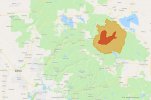I think two effects are at work.
Our brains are wired to see patterns, so it is hard to see something without automatically classifying it as something you already know. Drones are also in the news, so this will tend to increase the number of unknown objects reported as drones. Hence false sightings.
Also, a lot more drones are being sold, marketed as toys, selfie cameras, etc. In Canada the big box stores don't mention when selling that you need to have a license to fly a drone (250g or heavier), and don't mention the restrictions on where you can fly, so a lot of people have bought a cool toy and have no idea of their legal responsibilities — and when they go on Youtube they see all manner of people doing cool-looking reckless and illegal things without mentioning that they are reckless and illegal — and so they fly like that. Hence more ignorant/stupid people flying drones where they shouldn't.
So lots of false reports, but also more real incidents too.
(Last week I saw someone flying a Mavic to the east of me, over a shopping centre/apartment complex/major road. Built-up area, lots of vehicles and people, and well inside the control zone for our airport*. They were just buzzing around, swooping and spiralling, so I really doubt it was a professional with an Advanced License and an SFOC from Transport Canada. Probably a new pilot playing around or showing off to friends, but in an incredibly unsafe manner. Did they know it was unsafe and illegal? Possibly not, but then we also get idiots who aim lasers at low-flying aircraft for kicks and giggles, so possibly they just didn't care.)
*Not so close as to require unlocking from DJI, but close enough to require you to click the "I accept responsibility" button before taking off.












